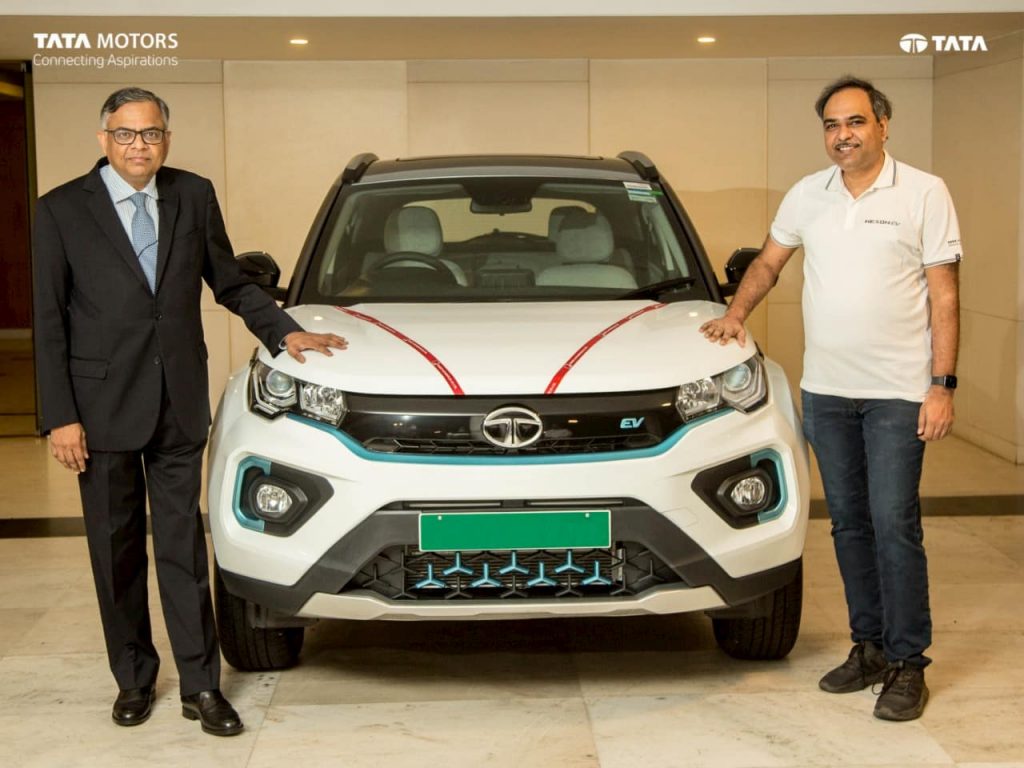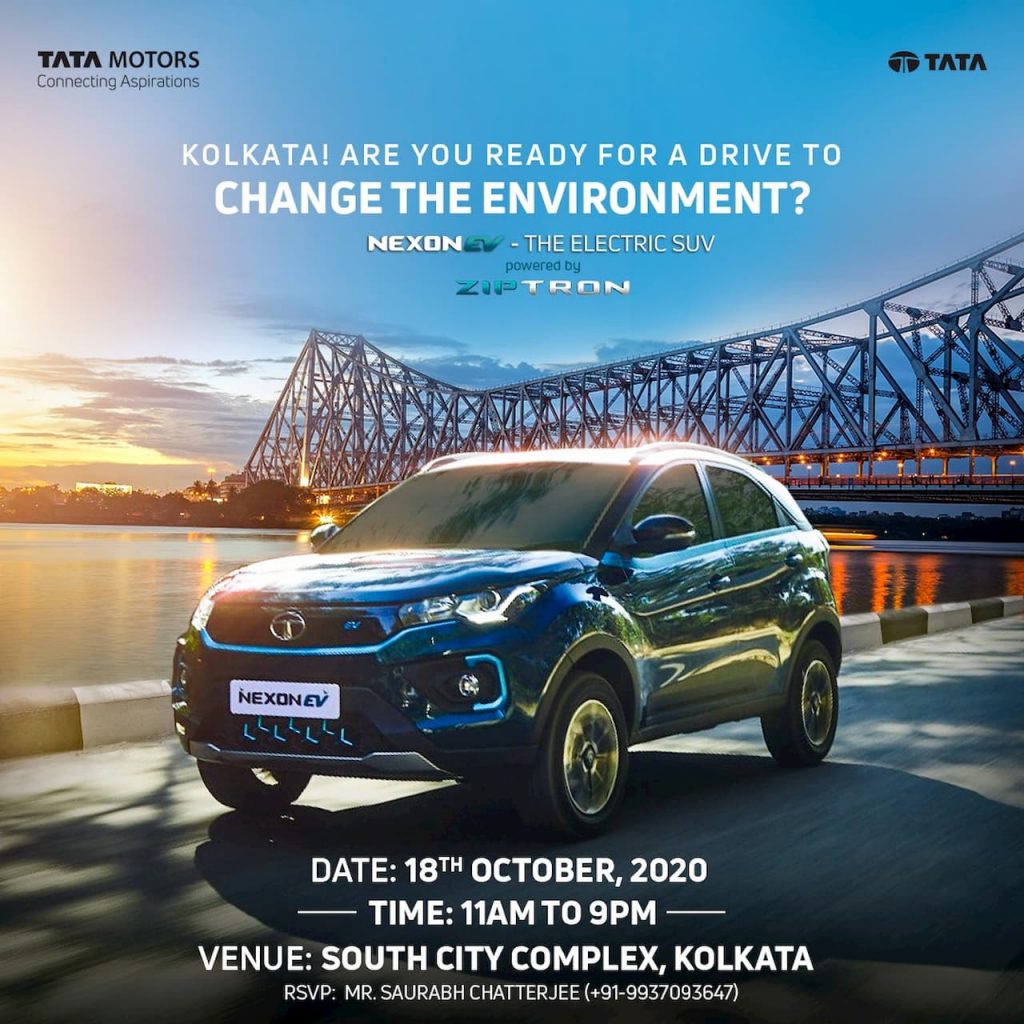The Tata Nexon EV, India’s best-selling electric car, has received a small visual update. The new electric SUV comes with an updated lower grille akin to the Nexon which was updated last month.
Last month, Tata Motors slightly altered the design of the Nexon, which it offers with 1.2L petrol and 1.5L diesel engines. The company replaced the Tri Arrow pattern on the lower grille with a new ‘Bi Arrow’ pattern, and now, it has applied the change on the Nexon EV (display image sourced from the official website reflects the revision). Notice that the blue accent on the grille is present on only the two arms of the inverted Y.
Last month reports in the Indian web were rife with speculation on the Tri Arrow’s likeness to the 95-year old Mercedes Three-Pointed star as a reason for the rework. The Tri Arrow pattern first appeared on the ‘IMPACT Design 2.0’ design philosophy that was launched at the Auto Expo 2018 as a bolder and sharper iteration of its predecessor. Tata Motors, a company that is deeply rooted in design, is yet to offer an explanation for the unexpected change but first notified dealers of the design.
The Tata Nexon EV is the company’s first long-range electric vehicle with a 312 km range (ARAI) but the first major update to the product could unlock more range and performance. Earlier this year in an interaction with Overdrive’s Bertand Dsouza on Instagram.com, Mr Anand Kulkarni, Vehicle Line Director, Product Line Electric Vehicle Business (Passenger Cars) had said that the Ziptron technology will continue to be improved and benefit in the aspects of range, performance and efficiency. This is not surprising considering that EVs from any car company regularly get updated with extended range and more performance. For example, the first generation of Nissan Leaf offered a range of only 175 km, which now stands at 378 km (NEDC).
In an interaction with PluginIndia posted on instagram.com, Kulkarni suggested that updates related to its infotainment system and connected vehicle services would come over-the-air. Crucial updates like those related to the motor, battery management system or other components that can improve the performance and range and/or fix any drive-related problems would be done at the service centres. Below is what he said:
The OTA updates are not to the traction unit. The OTA updates are to the infotainment and to the telematics unit. And those over-the-air updates are currently being provided for telematics and the infotainment services. But whatever updates we provide to our customers in terms of even traction unit, they can be offered, like they are being offered now, through our dealerships and service stations.
Anand Kulkarni, Product Line Director – EV & ALFA Architecture, Tata Motors (PVBU)
The continuous advancements in technology also enable EV manufacturers to pack in more range without proportionally expanding the battery size. Secondly, the reducing price of the battery gives the manufacturer opportunity to either offer more range or the same configuration at a lower price (theoretically). In a report published by BloombergNEF (BNEF) in December 2019, it was stated that battery prices have fallen 87% from USD 1,100/kWh in 2010 to USD 156/kWh in 2019 and is heading closer to USD 100/kWh within 2 years.

The Tata Tigor EV is an example of upgrades bringing in added range. Last year the Tigor EV received a bigger 21.5 kWh battery with the range extending up to 213 km per charge.
The range is not just restricted to the battery capacity. The European specification Hyundai Kona gets upgraded range for the same 64 kWh battery, where the range increased to 484 km from 449 km (WLTP) with the help of chassis modifications and low-rolling-resistance tyres.
Here are excerpts from the first chat with Mr Kulkarni:
What are the advancements that we can expect on the next Tata electric cars compared to the Tata Nexon EV from a technology standpoint?
We would want to make sure that the Ziptron platform that we have launched which is a high-voltage architecture with permanent motors and batteries that are IP67 sealed continue to go forward. There will be a couple of additional aspects that we might do in terms of incremental benefits for range or for performance or efficiency. This is actually a product-related question because these changes tend to get accompanied with products. We will get back to you when we have things to disclose on this.
On the differences between the Electra powertrain used in the Tigor EV and Ziptron used on the Tata Nexon EV –
Please note that when I tell you this answer, it’s also got to be looked at from a perspective of each of these cars being used for a specific use-case and therefore let’s appreciate why it has been done also.
The Tigor EV uses low-voltage architecture and the Tata Nexon EV uses high-voltage architecture. If you look at it technically, anything which is below 60 V is called low-voltage and anything that uses above 60 V is called high-voltage. Tigor EV is actually 72 V, from a technical perspective it is at high-voltage but in a real sense, it is not. So these are two big differences.
The second thing is the motor which is used on the Tata Nexon EV is a permanent magnet synchronous motor which gives very high efficiency and this motor tend to be more available in the high voltage format. And therefore it gives higher efficiency and higher power as well. The power density on this motor is quite high in a smaller space. The other thing is the amount of range that we have packed in. The Tigor EV has two versions – 16.5 kWh battery and 21.5 kWh battery, while the Tata Nexon has a 30.2 kWh battery. These are the major differences.
With respect to bringing down the cost of EVs, Mr Shailesh Chandra, President, Tata Motors Passenger Vehicles & Electric Vehicles, told ElectricVehicleWeb in February that localising the main components, more volumes and reduced battery costs will drive down the cost of EVs.
During the Tata Motors Q3 FY 2020 Earnings Conference Call on 30 January, he said:
Taco (Tata Components) has localized the battery pack (for the Tata Nexon EV), and going forward, we have plans to also localize motor for us. Tata Chemicals has also been working with us for cell manufacturing, and we are going to start the pilot plant in Dholera, in Gujarat.
Shailesh Chandra, President, Tata Motors Passenger Vehicles & Electric Vehicles
The Tata Nexon EV needs a step-up in travel range next year as its first competitor, the Mahindra eXUV300 arriving in mid-2021, is promised with a range of 375 km. The eXUV300 will have both standard and performance editions.
Tata Motors has confirmed that it has a few electric cars in the pipeline. The next launch is the Tata Altroz EV which is waiting in the wings since March 2019 when it was presented at the Geneva Motor Show. Looking further ahead, an electric version of the Tata HBX is expected as the company’s cheapest electric car when it arrives in 2022. A third crossover model (akin to the Tata Sierra EV) and a sedan (either the successor to the Tigor EV or a C-segment sedan) are speculated to receive the Ziptron tech as Tata Motors tries to strengthen its leadership position in the EV market with a full range of Tata electric cars.



![Will the launch of the Tata HBX EV get pushed to 2023? [Update]](https://electricvehicleweb.com/wp-content/uploads/2020/12/Tata-HBX-H2X-Hornbill-interior-dashboard-spy-shot-350x166.jpg)
![Everything we know about the upcoming Tata Altroz EV [Update]](https://electricvehicleweb.com/wp-content/uploads/2020/02/Tata-Altroz-EV-side-view-1-Auto-Expo-2020-350x234.jpeg)
![New Tata Safari a serious candidate for an electric vehicle [Update]](https://electricvehicleweb.com/wp-content/uploads/2021/02/Tata-Safari-EV-350x242.jpg)